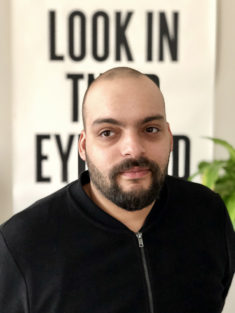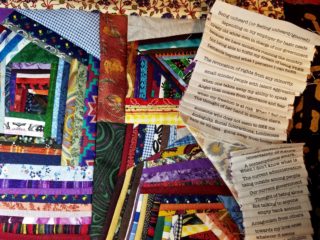Short description:
Practicing Distance is a multi-part guide for preparing for our futures together post-quarantine. In each part, Jeff Kasper offers a series of short practices, beginning with an introduction on four proxemic distances—intimate, personal, social, public—then facilitating guided creative exercises to engage with solo or with a partner in imagined physical proximity during the time of the pandemic and beyond.
Content Warning:
In this article the author discusses practices for navigating conflict and harm in relationships. There is mention of intimacy violence, partner-based violence and abuse. Please note that the following exercises are used outside of clinical spaces of medicine and are not created by medical professionals but instead center the perspectives of queer-disabled-survivors-of-color. Seek the advice of professionals if you need help. If you experienced or witnessed violence, or are you concerned about someone who has - The Anti-Violence Project (AVP) has a 24 Hour English/Spanish Hotline: 212-714-1141, or call the National Sexual Assault Hotline 1-800-656-4673 (HOPE). Feel free to use and adapt these activities as part of your arts-based community-building work, self-care, and peer-based support.
For more context, see Introduction.
Public distance [12 feet or more]: how to prepare for when proximity means harm
Public space—the area of space beyond which people will perceive interactions as impersonal and relatively anonymous.
As recently reported in the New York Times, and in reports issued by the Substance Abuse and Mental Health Services Administration (SAMHSA), there is a concern that the number of people experiencing intimate partner violence and family-based abuse will dramatically rise as a result of social distancing and quarantine during COVID-19. Not everyone’s home is the most safe location during “shelter in place.” Before the pandemic, a survivor or victim could flee a violent situation and seek help in the public sphere or from others in their social environment. For many, such options aren’t easily available right now. A stay-at-home order can force people to stay in a dangerous situation. [1]
“The Centers for Disease Control and Prevention (CDC) defines Intimate Partner Violence (IPV) as “physical violence, sexual violence, stalking and psychological aggression (including coercive tactics) by a current or former intimate partner or family member.” These types of behavior can happen concurrently, vary in frequency and severity, and range in lasting impact.”
People surviving violence in their partnerships, families, and most close-knit relationships may be experiencing increased isolation and danger caused by social distancing during the COVID-19 pandemic. Despite relative anonymity, public spaces can increase opportunities to participate in communal activity. Public space plays a vital role in the social life of communities. In the best of instances, social relations at this distance act as a shared resource in which experiences and values are created and safety is maintained between members. Think of those acts of neighborly mutual aid that can characterize some public encounters. For many, the opportunity to “be in public” fosters a social effect much in reverse to what the proxemic definition of public suggests—that it can support solidarity through privacy. It feels kind of off that public space would offer what we most often think of as reserved in the private sphere—the sector of social life in which an individual enjoys a degree of authority, unhampered by the influence of governing institutions. [2] But the parameters separating public and private spheres are not fixed and vary a great deal across culture, place, and time. For some, public space can provide the functions of privacy—autonomy, emotional release, self-evaluation, and protected communication—especially when our most intimate domestic spaces and the relationships associated with them are marked with abuse, harm, and violence. [3] People seek support in public for matters most close to home. Retreat from public contact, added stress and financial strain can negatively impact survivors and create circumstances such as further isolation, fear of retaliation and shame, further compromising the situation. People need the option to be in public distance in order to maintain safety. Pandemics illuminate how this is just not always possible. With that in mind: What are the tools that we can use to mobilize our networks of relationships to prepare for when harm occurs in private?
The Bay Area Transformative Justice Collective (BATJC) notes that many people who experience violence, harm or abuse that is close to home (or who have committed acts of harm or abuse) often turn to their closest social networks before they consult external state or social services. Most people don’t call the police or seek counseling or even call anonymous hotlines. If they tell anyone at all, they turn to a trusted friend, family member, neighbor or coworker. In considering this BATJC wanted a way to name those currently in your life that you would rely on (or are relying on) to respond to violence, harm and abuse. The term created for these groups is “pods."
“During the spring of 2014 the Bay Area Transformative Justice Collective (BATJC) began using the term 'pod' to refer to a specific type of relationship within transformative justice” work. A new term was needed to describe the kind of relationships between people who would turn to each other for support around violent, harmful and abusive experiences, whether as survivors, bystanders or people who have harmed. These would be the people in our lives that we would call on to support us with things such as our immediate and on-going safety, accountability and transformation of behaviors, or individual and collective healing and resiliency.
Prior to this, many had been using the term 'community' but found that, not surprisingly, many people do not feel connected to a 'community' and, even more so, most people did not know what 'community' meant or had wildly different definitions and understandings of 'community.'”
-- Written by Mia Mingus for BATJC, June 2016
I highly recommend using the BAJTC's worksheet to start to identify who could be in your “pod(s)." A “pod” is a microcosm of “community.” Since it’s more concrete than the vague notion of community, it’s easier to get organized—to connect, make a plan, and follow through if and when it’s needed. There may be certain qualities you look for in the folks in your pod(s): maybe they’re really reliable, well-resourced, generous, committed, kind. Maybe they have certain skills that you don’t and need. Maybe they live nearby. This practice is grounded within a transformative justice* philosophy. [4]
As Mia Mingus writes on the worksheet:
"Your pod(s) may shift over time, as your needs or relationships shift or as people’s geographic location shifts. Have conversations with your pod people about pods and transformative justice, as well as to actively grow the number of people in your pod and support each other in doing so. Growing one’s pod is not easy and may take time. In pod work, we measure our successes by the quality of our relationships with one another and we invest in the time it takes to build things like trust, respect, vulnerability, accountability, care and love. We see building our pods as a concrete way to prepare and build resources for transformative justice in our communities."
Download the BAJTC Pod Mapping Worksheet
Note: ‘Pod Mapping’ is not a solution to abuse and harm but only one tool for building up one's capacity to navigate harm when it occurs. I recommend that you learn more about transformative justice and community accountability resources that can expand your repertoire while dealing with harm in our collective and social spaces.
*Vocabulary: Transformative justice is a way of addressing an individual act of harm that relies on community members instead of the police, the law, or the government (also known as the State). It is a response to the racism, ableism, and gender-based oppression that shapes contemporary life. Though models differ widely based on place and time, all reject the criminal-justice system, choosing instead to rely on community support networks and mediators.
The author donated the fee for writing this article to BATJC. You can support their work here.
Footnotes:
[1] SAMHSA, “Intimate Partner Violence and Social Distancing,” https://www.samhsa.gov/sites/default/files/social-distancing-domestic-violence.pdf)
Amanda Tuab, “How Domestic Abuse has Risen During COVID-19,” The New York Times, April 14, 2020, Accessed: April 14, 2020 https://www.nytimes.com/2020/04/06/world/coronavirus-domestic-violence.html?referringSource=articleShare
[2] Public” and “private” space are highly gendered and classed concepts. Learn more: Jurgen Habermas. The Structural Transformation of the Public Sphere: An Inquiry into a Category of Bourgeois Society. Translated by Thomas Burger; Frederic Lawrence. Massachusetts: MIT Press. 1989; Christopher Wells. "Separate Spheres". In Kowaleski-Wallace, Elizabeth (ed.). Encyclopedia of feminist literary theory. London, New York: Routledge. 2009.
[3] Alan F. Westin. Privacy and Freedom. New York: Atheneum, `1967.
[4] I learned more about this practice by Queens-based artist and activist, Ro Garrido who led a workshop at Downtown Art as part of my 2019 residency series Give & Take Care. Learn more about Pod Mapping on the BATJC website: https://batjc.wordpress.com/pods-and-pod-mapping-worksheet/


